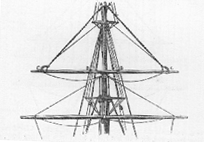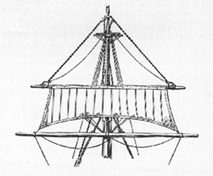
The sail can be wound up entirely on the rolling spar, like a
"window-blind", by means of a parbuckle or reefing halyards, which leads from
the topmast head to the yard-arms, and adds materially to the strength,
insomuch that it will be next to impossible to carry the yards away with this
arrangement. The whole construction is so very simple, that any seaman
immediately understands it on once seeing it. This invention can easily be
applied to ships having no reefing apparatus, as it is not necessary to alter
the yards or sails -- only the points are to be taken out and reef-cringles.
The sails being reefed without straining or shaking, will wear much longer,
and are much more simple in their construction, and cost less at the first
cost, there being no reef-points, bands, or gasket.

A great number of ships having been fitted, and having been used in all climates and all weathers, has proved them to answer all that could be desired in a self-reefing sail.
This invention will be readily understood by reference to the accompanying sketches, and also enable any one to fit up the Apparatus.

The crutches, DD, as per sketch (see p. 175), for supporting the middle of the roller, should be placed -- say for a 30 feet roller -- 3 feet from the sling hoop; and, for a 40 feet roller, 4 feet from the sling hoop, and so on in proportion to the length of the roller. Care should be taken in fixing the journals, carrying the ends of the roller, so that it will be directly in front of the yard: and, before the crutches are made securely fast, the roller should be allowed to bear its own weight upon the spindle; they should then be placed, so that the roller comes near to the topside, so that the roller will bear a great part of the weight before yielding to the crutches, and thus enable it to work much easier, and without friction to the sail. In all cases the stud in the sling hoop should be on the fore cant of the yard.
The battens to be left 6 inches short on each of the crutch, and one should be made of hard wood, to form a jack-stay, and in no case should they go without the leech-rope of the sail; they should be of the same thickness as the leech-rope is in diameter.
The roller should swell 1/2 or 3/4 of an inch in the middle.
To Furl. -- The sail being thus close-reefed, the topsail halyards are made fast, the sheets are then "started", and by hauling on the reefing halyards, the whole sail is wound easily on, and thus furled without sending a man aloft.
To Unfurl. -- Let go the reefing halyards and haul the sheets home, then pull on the topsail halyards, and as the yard ascends, the chains are wound round the roller again, [1] and the whole sail set as required.
It will be observed that when the sail is furled the
chains are unwound, except about half a turn round the roller.
Transcribed by
Lars.Bruzelius@udac.se
Sjöhistoriska Samfundet | |
Rigging |
Search.
Copyright © 1996 Lars Bruzelius.
From Robert Kipping: Elementary Treatise on Sails and Sailmaking
with Draughting, and the Centre of Effort of the Sail . . .
Together with an Appendix, Comprising the Inventions of
Self-Reefing Topsails of Captain Cunningham &etc. and Captain
Howe; and Also a Cutting Board or Table, by Mr. Pittard.
5th ed., enl. and greatly improved.
C. Wilson, London, 1860-61 (5th). pp 168-169 [?].
Weale's Rudimentary Series, No. 149.
First published in 1847.